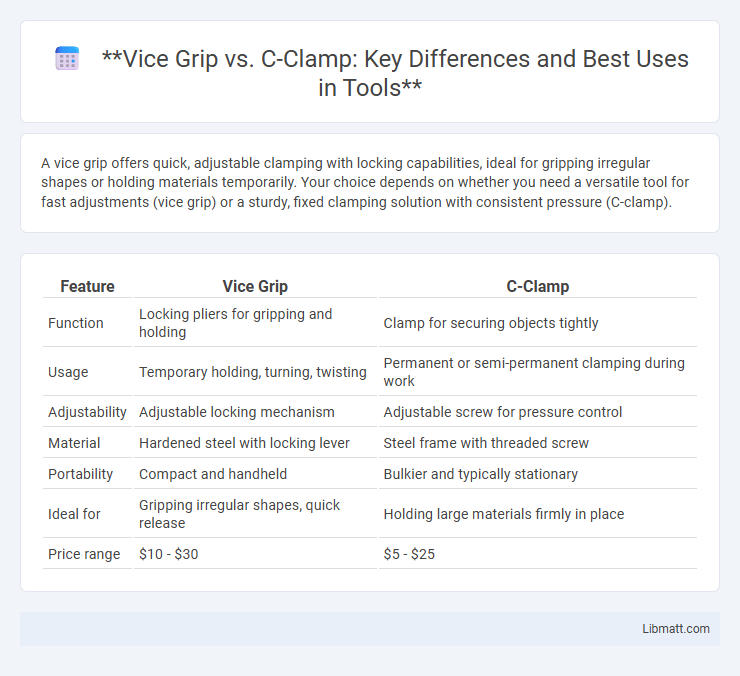A vice grip offers quick, adjustable clamping with locking capabilities, ideal for gripping irregular shapes or holding materials temporarily. Your choice depends on whether you need a versatile tool for fast adjustments (vice grip) or a sturdy, fixed clamping solution with consistent pressure (C-clamp).
Table of Comparison
| Feature | Vice Grip | C-Clamp |
|---|---|---|
| Function | Locking pliers for gripping and holding | Clamp for securing objects tightly |
| Usage | Temporary holding, turning, twisting | Permanent or semi-permanent clamping during work |
| Adjustability | Adjustable locking mechanism | Adjustable screw for pressure control |
| Material | Hardened steel with locking lever | Steel frame with threaded screw |
| Portability | Compact and handheld | Bulkier and typically stationary |
| Ideal for | Gripping irregular shapes, quick release | Holding large materials firmly in place |
| Price range | $10 - $30 | $5 - $25 |
Introduction to Vice Grip and C-Clamp
Vice grips and C-clamps are essential tools used in various mechanical and woodworking applications for securing objects firmly. Vice grips, also known as locking pliers, feature adjustable locking mechanisms that provide strong, hands-free clamping pressure, ideal for gripping irregular shapes. C-clamps consist of a simple screw mechanism that tightens a metal frame around a workpiece, offering versatility and stability for tasks requiring steady clamping force.
Defining Vice Grips: Features and Uses
Vice grips are locking pliers designed with an adjustable mechanism that securely clamps onto objects, providing a strong hold for gripping, twisting, or turning tasks. Their self-locking feature distinguishes them from C-clamps, allowing for quick adjustments and release with one hand, making them essential in automotive and metalworking applications. You can rely on vice grips for temporary yet sturdy holds on irregularly shaped objects where precision and ease of use are critical.
What is a C-Clamp? Key Characteristics
A C-clamp is a versatile clamping tool used to hold objects tightly together during woodworking, metalworking, and welding projects. Its key characteristics include a C-shaped frame, a threaded screw for adjustable pressure, and a swivel pad that distributes clamping force evenly, preventing damage to the workpieces. Known for its strong grip and durable steel construction, the C-clamp offers precise control and stability in securing materials.
Design Comparison: Vice Grip vs C-Clamp
Vice grips feature a locking mechanism with adjustable jaws that tightly clamp and hold irregular or round objects, providing a secure grip ideal for welding or metalwork. C-clamps have a simple screw mechanism with a fixed frame shaped like the letter "C," designed to apply steady pressure on flat or wide surfaces, making them perfect for woodworking or gluing tasks. Your choice depends on the shape and stability needed, as vice grips excel in gripping and holding objects firmly while C-clamps deliver consistent clamping force over larger, flat areas.
Clamping Force and Holding Power
The Vice grip offers adjustable clamping force with locking mechanisms that provide strong holding power, ideal for gripping irregular shapes and quick adjustments. In contrast, the C-clamp delivers consistent, high clamping force through a screw mechanism, making it better suited for stable, heavy-duty applications requiring firm, static pressure. Your choice depends on whether you need versatile, quick clamping or reliable, long-term holding strength.
Versatility and Common Applications
Vice grips offer greater versatility with their locking mechanism, enabling secure clamping on irregularly shaped objects and quick release, making them ideal for automotive repairs, welding, and metalworking. C-clamps provide strong, stable pressure on flat surfaces, commonly used in woodworking, assembly, and holding materials during gluing or drilling. Both tools are essential in workshops, but vice grips excel in adjustable, temporary clamping while C-clamps are preferred for precise, fixed holds.
Ease of Use and Adjustability
Vice grips offer quick one-handed operation with an easy-to-use locking mechanism, making them highly adjustable for various clamping pressures and sizes. C-clamps require manual tightening with a screw mechanism, providing precise but slower adjustments that demand both hands. The ease of use in vice grips suits fast tasks, while C-clamps excel in applications needing strong, stable holds with fine-tuned pressure control.
Durability and Material Differences
Vice grips are typically constructed from hardened steel, offering exceptional durability and resistance to wear under high-torque applications. C-clamps, often made from cast iron or steel, provide strong clamping force but may be more prone to deformation or cracking under extreme pressure. The choice between the two hinges on the need for long-lasting strength versus specific clamping versatility in various industrial or workshop environments.
Cost Considerations
Vice grips generally offer a more affordable option compared to C-clamps, with prices ranging from $10 to $30 depending on size and brand. C-clamps tend to be slightly more expensive, often priced between $15 and $50, due to their robust design and material quality. Budget-conscious buyers should weigh the cost against intended use, as vice grips provide quick clamping ability while C-clamps deliver stronger, more stable holds for heavy-duty projects.
Choosing the Right Tool: Vice Grip or C-Clamp?
Vice grips excel in providing quick, adjustable clamping with strong gripping power, making them ideal for locking irregular or rounded objects securely during welding or automotive repairs. C-clamps offer superior stability and uniform pressure for woodworking, metalworking, and precise assembly tasks, thanks to their fixed frame and adjustable screw mechanism. Selecting between a vice grip and a C-clamp depends on the need for rapid adjustments versus consistent, strong clamping force on flat or shaped surfaces.
Vice grip vs C-clamp Infographic

 libmatt.com
libmatt.com